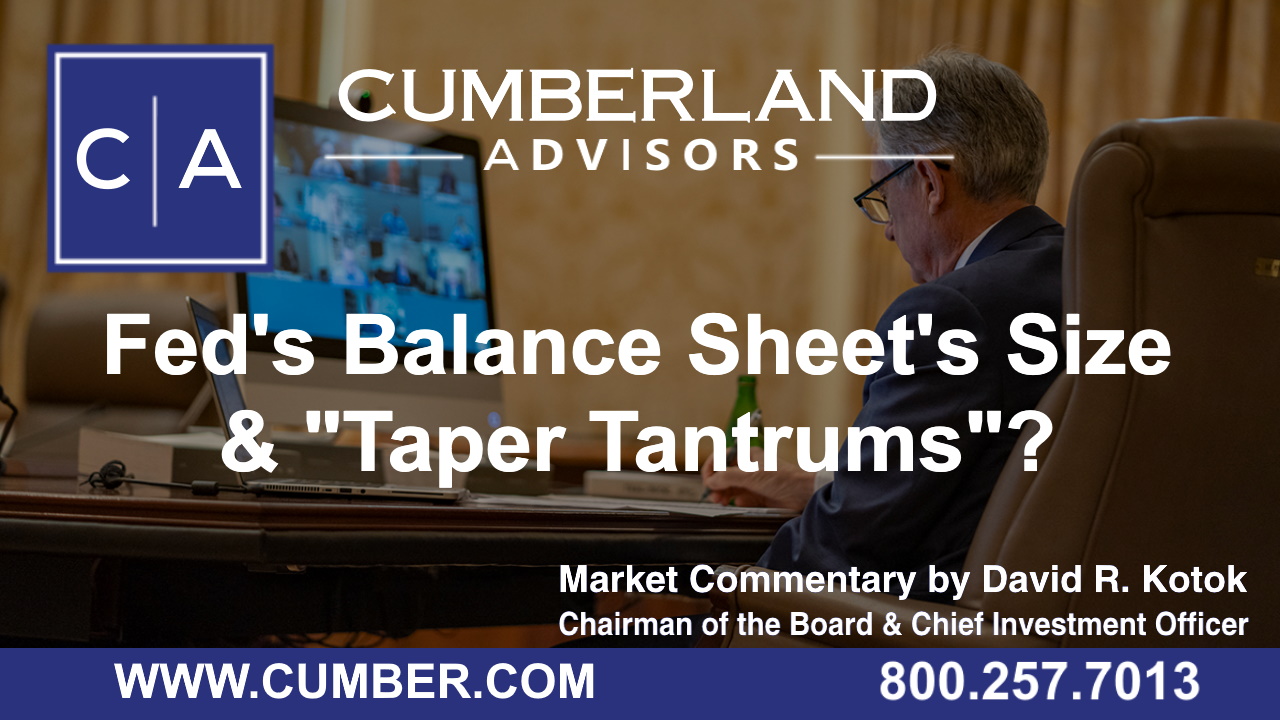At their excellent blog, Money, Banking and Financial Markets (https://www.moneyandbanking.com/), Professors Steven (Steve) Cecchetti and Kermit (“Kim”) Schoenholtz have posted an extraordinary tutorial about the size of a central bank’s balance sheet and its implications.

Here’s the link to the post, titled “Stopping central banks from being prisoners of financial markets”: https://www.moneyandbanking.com/commentary/2021/4/17/stopping-central-banks-from-being-prisoners-of-financial-markets. Cecchetti is the Rosen Family Chair in International Finance at the Brandeis International Business School), and Schoenholtz is Professor of the History of Financial Institutions and Markets at New York University’s Leonard N. Stern School of Business. The two men have collaborated on their blog, which is dedicated to teaching about finance and economics. They have also co-authored a textbook which I highly recommend for serious investors.
The authors offer a recommendation to policy makers about communications, and they illustrate the risks and penalties that can attend a “taper tantrum.” Investors may wish to read their post slowly and twice and then contemplate the issues involved with sizing of the balance sheet when making monetary policy as a central bank.
In an informal way we want to add comments as a discussant to this exquisite paper.
We constantly hear criticism of Fed leaders and ECB or BOJ or others. Lots of pundits give advice and criticism but few propose thoughtful alternatives and why their alternatives are more valid. So the Fed talk (TV, print, social media) is asymmetric. That is why this paper is so important. It is not asymmetric. It demonstrates the problems and specifies the issues.
What we don’t hear in the TV, etc. arguments is the prescription for an optimal central bank balance sheet size and why that size is optimal. We do sometimes hear a rationale attached to a single specific decision, as these skilled authors have discussed in detail. But that lack of an optimal sizing debate is the Shakespearean “rub.” Prior to the Great Financial Crisis, the whole discussion revolved around setting the short term interest rate. Using balance sheet size (QE) is a very new tool.
We would add a discussant’s question to those already raised in this superb post. Isn’t the composition of the central bank’s portfolio assets just as critical or maybe even more critical than the size? Doesn’t duration matter? Isn’t there a difference between the Fed’s holding $2 trillion of T-bills versus $2 trillion of 30-year bonds? Asset size is identical and all debt is US Treasury debt yet the market impact of those differing holdings is vastly different.
Also, why not match liabilities with assets? For example, if currency in circulation is $2 trillion and increasing $200 billion a year, why not view that as a permanent and growing liability and match it with a predictable ladder of long-term Treasury notes and bonds? The same can be said for the baseline balance of the checking account of the US Treasury. Note, we have just made the case for $2.5 trillion permanent and rolling portfolio of long term Treasury bonds.
The Fed and others such as the ECB and BOJ are attempting clarity about their inflation targets (2% plus for a sustained period). Cecchetti and Schoenholtz argue for similar clarity about balance sheet size.
We agree. Markets will have better price discovery if the balance sheet size questions and the rationale behind them become clearer. We applaud Cecchetti and Schoenholtz for tackling a very difficult question.
At Cumberland, our US ETF portfolios have a cash reserve; quant portfolios are defensive; and bonds are using defensive strategies and barbells.
David R. Kotok
Chairman of the Board & Chief Investment Officer
Email | Bio
Links to other websites or electronic media controlled or offered by Third-Parties (non-affiliates of Cumberland Advisors) are provided only as a reference and courtesy to our users. Cumberland Advisors has no control over such websites, does not recommend or endorse any opinions, ideas, products, information, or content of such sites, and makes no warranties as to the accuracy, completeness, reliability or suitability of their content. Cumberland Advisors hereby disclaims liability for any information, materials, products or services posted or offered at any of the Third-Party websites. The Third-Party may have a privacy and/or security policy different from that of Cumberland Advisors. Therefore, please refer to the specific privacy and security policies of the Third-Party when accessing their websites.
Sign up for our FREE Cumberland Market Commentaries Cumberland Advisors Market Commentaries offer insights and analysis on upcoming, important economic issues that potentially impact global financial markets. Our team shares their thinking on global economic developments, market news and other factors that often influence investment opportunities and strategies.

